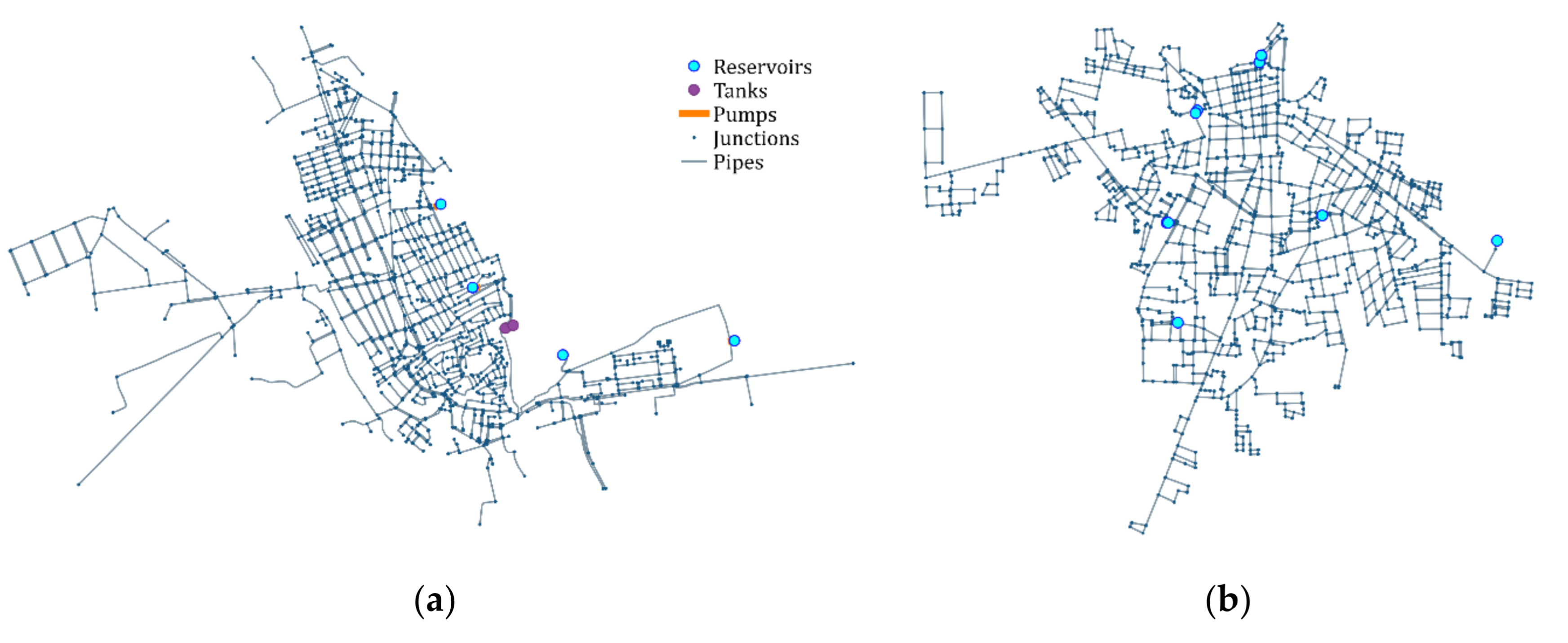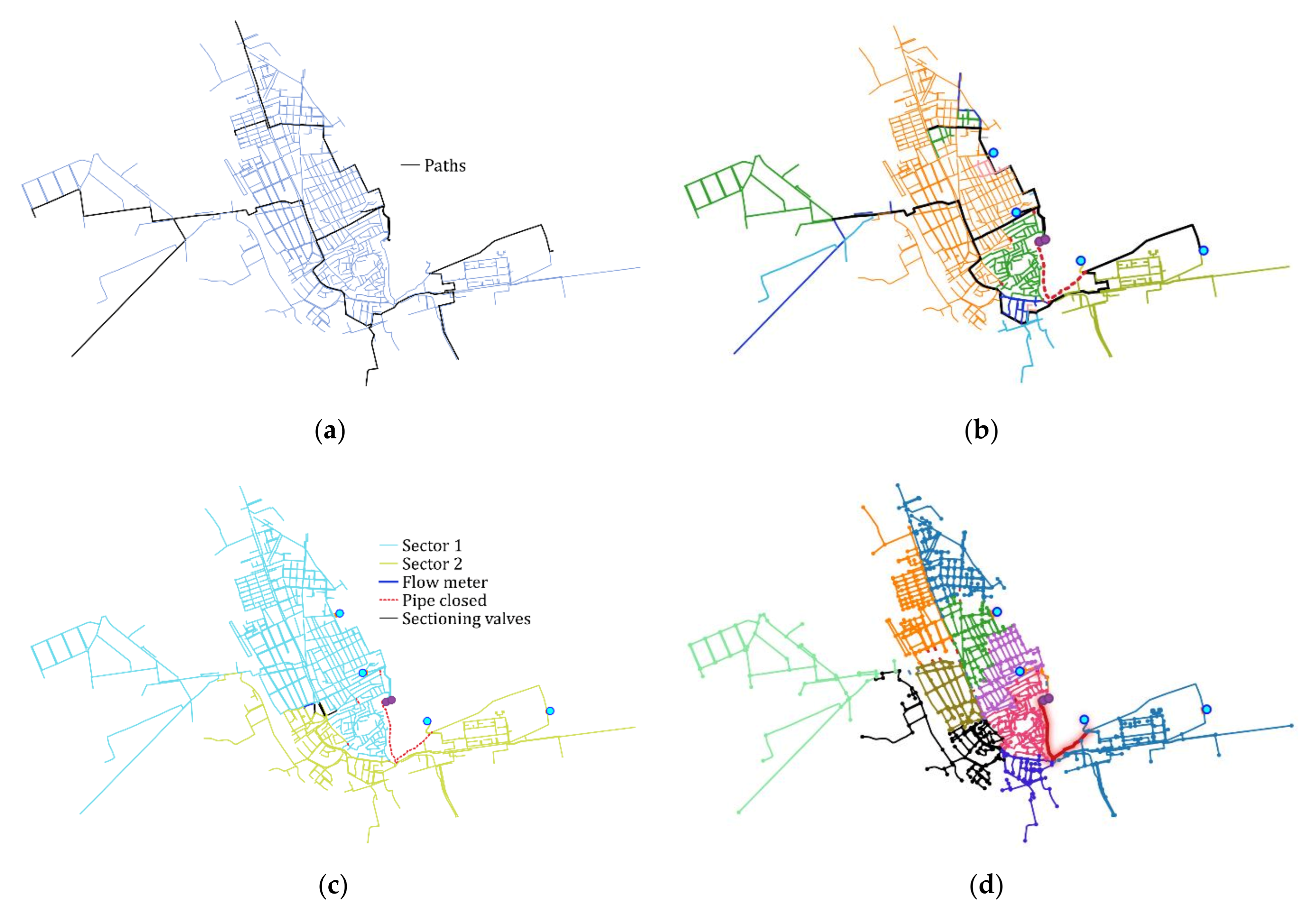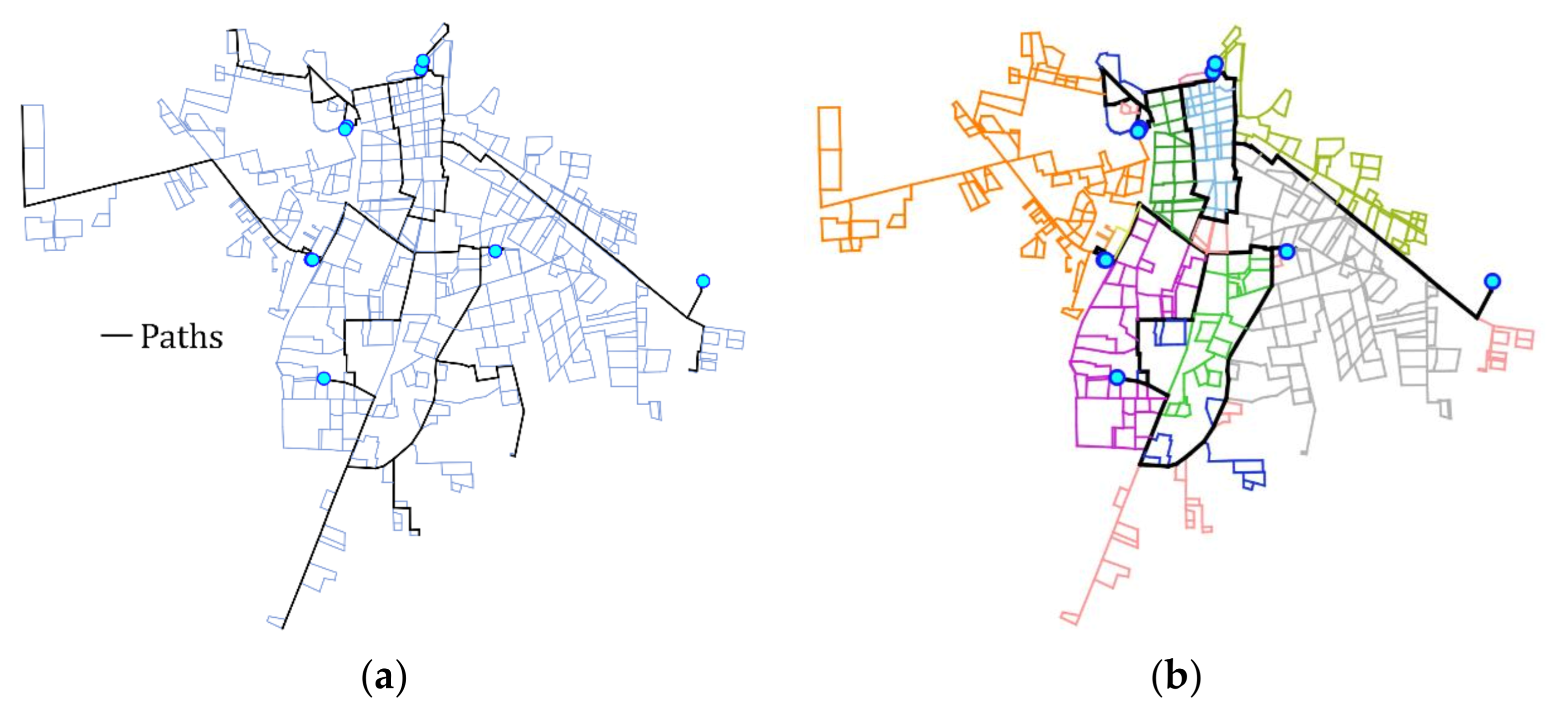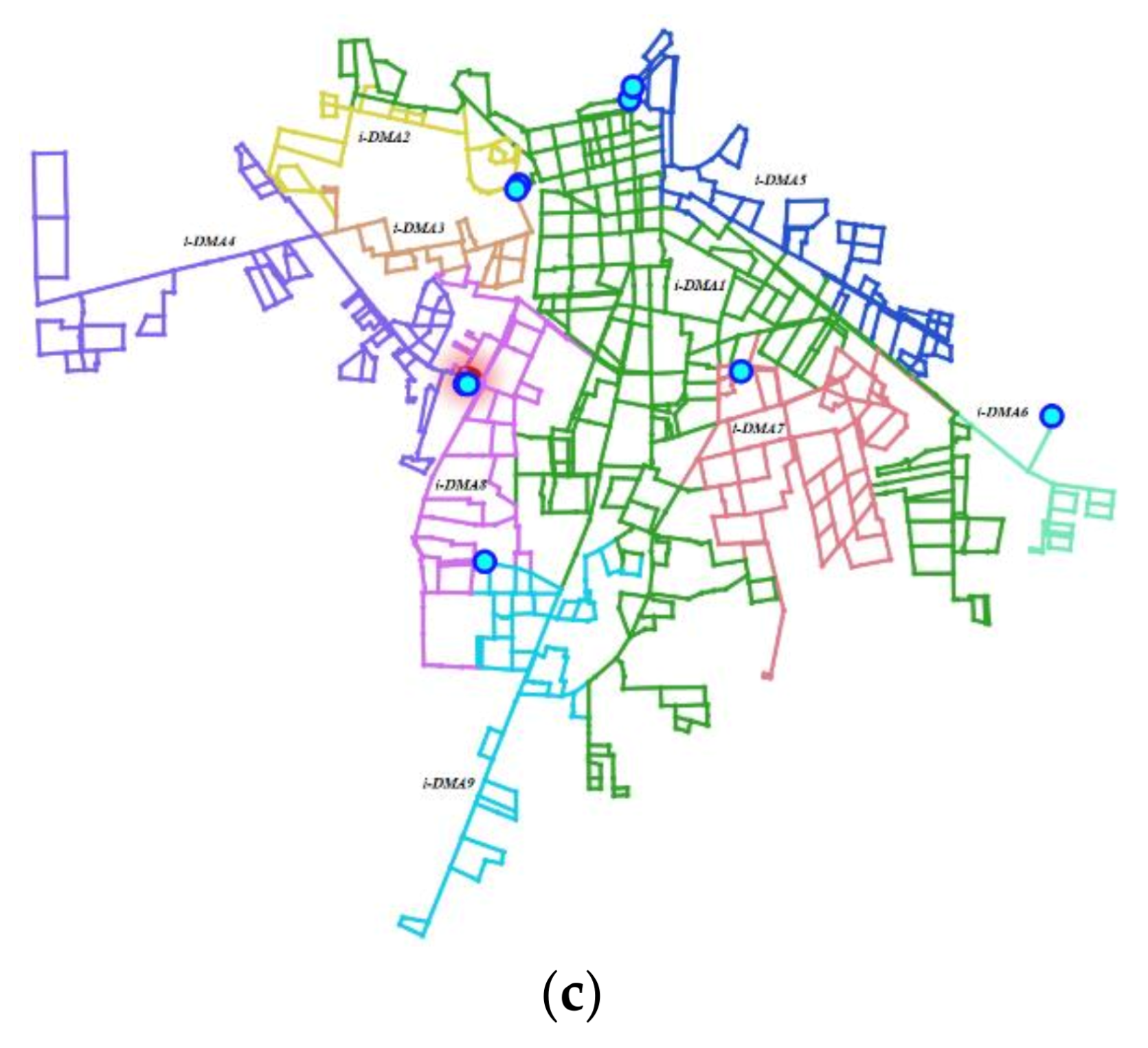A Decision Support Tool for Water Supply System Decentralization via Distribution Network Sectorization
Abstract
:1. Introduction
2. Methodologies
2.1. The Network Hydraulic Modelling
- To obtain the pipe flows and its direction at a given time (usually the hour of maximum demand), which will be used by the search algorithms.
- To obtain the percentage of the contribution of each water sources to the consumption at each node, which will be used by the second method to separate the sectors by sources, and in the first method to complete the sectorization.
- To check the maximum and minimum pressures at the inner nodes of each sector, depending on the pipes to be closed and the flow entry points for each sectorization proposed.
- The model should represent all hydraulic elements of the network as they are. That is, if there are two sources of supply (reservoirs or flow injection points) and five tanks, they must be represented exactly in the same way in the model. If it is assumed that tanks are the supply sources, the expected results may not be interpreted correctly.
- The layout of the pipes must be checked and correct (if necessary). This is important to determine the number of flow meters that feed the sectors, and to know their origin when it comes to cascading sectors. To this end, a special additional software tool has been developed by the authors that allows changing pipe orientation if it is found that the flow through these elements is always negative throughout the simulation period. This application is called Reverse-Pipes [31] (see Supplementary Materials Reverse-Pipes) and is freely available from the ResearchGate website of the first author.
- If the layout of the whole network is not fully connected, the different subnetworks separated physically or by closure elements must be previously identified. This will help to better understand the results obtained from the sectorization schemes. With this aim, another tool called iDistricts [32] (see Supplementary Materials iDistricts), was implemented by employing a depth-first graph theory search algorithm, also freely available from ResearchGate for download.
2.2. Search Algorithms
2.3. Method 1. Sectorization by Previously Identifying the Arterial Network
2.4. Method 2. Sectorization According to the Contribution of the Sources to the Demand at the Nodes
3. Case Studies
3.1. Villena Network
3.2. Matamoros Network
4. Results and Discussions
4.1. Villena Network
4.2. Matamoros Network
4.3. Limitations of the Proposed Methodologies and Precautions in Their Use
4.3.1. Arterial Network Method
4.3.2. Supply Sources Contribution Method
5. Conclusions
Supplementary Materials
Author Contributions
Funding
Institutional Review Board Statement
Informed Consent Statement
Data Availability Statement
Acknowledgments
Conflicts of Interest
References
- Unesco International Centre for Water Security and Management. Water Security and the Sustainable Development Goals; UNESCO: Paris, France; Republic of Korea: Daejeon, Koera, 2019; I-WSSM, 2019; ISBN 9789231003233.
- Dominguez Torres, C. The Future of Water in African Cities: Why Waste Water? Urban Access to Water Supply and Sanitation in Sub-Saharan Africa, Background Report; World Bank: Washington, DC, USA, 2012. [Google Scholar]
- OECD. Alternative Ways of Providing Water. Emerging Options and Their Policy Implications. Advance Copy for 5th World Water Forum; OECD: Paris, France, 2007. [Google Scholar]
- Yang, H.; Abbaspour, K.C. Analysis of wastewater reuse potential in Beijing. Desalination 2007, 212, 238–250. [Google Scholar] [CrossRef]
- Bieker, S.; Cornel, P.; Wagner, M. Semicentralised supply and treatment systems: Integrated infrastructure solutions for fast growing urban areas. Water Sci. Technol. 2010, 61, 2905–2913. [Google Scholar] [CrossRef] [Green Version]
- Cornel, P.; Meda, A.; Bieker, S. Wastewater as a Source of Energy, Nutrients, and Service Water. Treatise Water Sci. 2011, 337–375. [Google Scholar] [CrossRef]
- Böhm, H.R.; Schramm, S.; Bieker, S.; Zeig, C.; Anh, T.H.; Thanh, N.C. The semicentralized approach to integrated water supply and treatment of solid waste and wastewater—a flexible infrastructure strategy for rapidly growing urban regions: The case of Hanoi/Vietnam. Clean Technol. Environ. Policy 2011, 13, 617–623. [Google Scholar] [CrossRef]
- Wang, X.C.; Chen, R.; Zhang, Q.H.; Li, K. Optimized plan of centralized and decentralized wastewater reuse systems for housing development in the urban area of Xi’an, China. Water Sci. Technol. 2008, 58, 969–975. [Google Scholar] [CrossRef]
- Weber, B.; Cornel, P.; Wagner, M. Semi-centralised supply and treatment systems for (fast growing) urban areas. Water Sci. Technol. 2007, 55, 349–356. [Google Scholar] [CrossRef]
- Bartolín, H. Confección de Modelos de Redes de Distribución de Agua Desde un SIG y Desarrollo de Herramientas de Apoyo a la Toma de Decisiones. Ph.D. Thesis, Universitat Politècnica de València, Valencia, Spain, 2013. [Google Scholar]
- Di Nardo, A.; Di Natale, M.; Greco, R.; Santonastaso, G. Ant algorithm for smart water network partitioning. Procedia Eng. 2014, 70, 525–534. [Google Scholar] [CrossRef] [Green Version]
- Gomes, R.; Sá Marques, A.; Sousa, J. Identification of the optimal entry points at District Metered Areas and implementation of pressure management. Urban Water J. 2012, 9, 365–384. [Google Scholar] [CrossRef]
- Morrison, J. Managing leakage by District Metered Areas: A practical approach. Water 21 2004, 6, 44–46. [Google Scholar]
- Sousa, J.; Ribeiro, L.; Muranho, J.; Marques, A.S. Locating Leaks in Water Distribution Networks with Simulated Annealing and Graph Theory. Procedia Eng. 2015, 119, 63–71. [Google Scholar] [CrossRef] [Green Version]
- Charalambous, B. Use of district metered areas coupled with pressure optimisation to reduce leakage. Water Sci. Technol. Water Supply 2008, 8, 57–62. [Google Scholar] [CrossRef]
- Di Nardo, A.; Di Natale, M.; Guida, M.; Musmarra, D. Water Network Protection from Intentional Contamination by Sectorization. Water Resour. Manag. 2013, 27, 1837–1850. [Google Scholar] [CrossRef]
- Grayman, W.; Murray, R.; Savic, D. Effects of Redesign of Water Systems for Security and Water Quality Factors. In Proceedings of the World Environmental and Water Resources Congress 2009, Kansas City, MO, USA, 17–21 May 2009; pp. 1–11. [Google Scholar]
- Herrera, M.; Abraham, E.; Stoianov, I. Graph-theoretic Surrogate Measures for Analysing the Resilience of Water Distribution Networks. Procedia Eng. 2015, 119, 1241–1248. [Google Scholar] [CrossRef] [Green Version]
- Todini, E. Looped water distribution networks design using a resilience index based heuristic approach. Urban Water 2000, 2, 115–122. [Google Scholar] [CrossRef]
- Saldarriaga, J.G.; Ochoa, S.; Rodriguez, D.; Arbelaez, J. Water Distribution Network Skeletonization Using the Resilience Concept. In Proceedings of the Water Distribution Systems Analysis 2008, Kruger National Park, South Africa, 17–20 August 2008; Van Zyl, K., Ed.; ASCE: Reston, VA, USA, 2008; Volume 340, p. 74. [Google Scholar]
- Tzatchkov, V.G.; Alcocer-Yamanaka, V.H.; Bourguett Ortíz, V. Graph Theory Based Algorithms for Water Distribution Network Sectorization Projects. In Proceedings of the 8th Annual Water Distribution Systems Analysis Symposium (WDSA), Cincinnati, OH, USA, 27–30 August 2006; pp. 1–15. [Google Scholar]
- Ciaponi, C.; Murari, E.; Todeschini, S. Modularity-Based Procedure for Partitioning Water Distribution Systems into Independent Districts. Water Resour. Manag. 2016, 30, 2021–2036. [Google Scholar] [CrossRef]
- Brentan, B.; Campbell, E.; Goulart, T.; Manzi, D.; Meirelles, G.; Herrera, M.; Izquierdo, J.; Luvizotto, E. Social Network Community Detection and Hybrid Optimization for Dividing Water Supply into District Metered Areas. Water Resour. Plan. Manag. 2018, 144. [Google Scholar] [CrossRef] [Green Version]
- Di Nardo, A.; Di Natale, M.; Giudicianni, C.; Greco, R.; Santonastaso, G.F. Water Supply Network Partitioning Based on Weighted Spectral Clustering. In Complex Networks & Their Applications V.; Cherifi, H., Gaito, S., Quattrociocchi, W., Sala, A., Eds.; Springer International Publishing: Cham, Switzerland, 2017; Volume 693, pp. 797–807. ISBN 978-3-319-50901-3. [Google Scholar]
- Han, R.; Liu, J. Spectral Clustering and Genetic Algorithm for Design of District Metered Areas in Water Distribution Systems. Procedia Eng. 2017, 186, 152–159. [Google Scholar] [CrossRef]
- Hajebi, S.; Barrett, S.; Clarke, A.; Clarke, S. Multi-agent simulation to support water distribution network partitioning. In Proceedings of the 27th European Simulation and Modelling Conference, Lancaster, UK, 23–25 October 2013. [Google Scholar]
- Herrera, M.; Izquierdo, J.; Pérez-García, R.; Ayala-Cabrera, D. Water Supply Clusters by Multi-Agent Based Approach. In Proceedings of the 12th Annual Conference on Water Distribution Systems Analysis, Tucson, AZ, USA, 12–15 September 2010; pp. 861–869. [Google Scholar]
- Di Nardo, A.; Di Natale, M.; Santonastaso, G.F.; Venticinque, S. An Automated Tool for Smart Water Network Partitioning. Water Resour. Manag. 2013, 27, 4493–4508. [Google Scholar] [CrossRef]
- Bui, X.K.; Marlim, M.S.; Kang, D. Water network partitioning into district metered areas: A state-of-the-art review. Water 2020, 12, 1002. [Google Scholar] [CrossRef] [Green Version]
- Rossman, L.A. EPANET 2. Users Manual; EPA: Cincinnati, OH, USA, 2000; Volume 38, ISBN EPA/600/R-00/057.
- Vegas, O. Reverse-Pipes. Herramienta para Cambiar la Orientación de Tuberías en Modelos de Epanet. 2021, 10. Available online: http://bit.ly/2KdoN20 (accessed on 10 February 2021).
- Vegas Niño, O.T.; Martínez Alzamora, F.; Tzatchkov, V.G. iDistricts. A Tool to Propose or Identify Hydraulic. Available online: https://bit.ly/3j1i3nB (accessed on 10 February 2021).
- Robert, E. Tarjan Depth-First Search and Linear Graph Algorithms. SIAM J. Comput. 1972, 1, 146–160. [Google Scholar] [CrossRef]
- Dijkstra, E.W. A note on two problems in connexion with graphs. Numer. Math. 1959, 1, 269–271. [Google Scholar] [CrossRef] [Green Version]
- Campbell, E. Sectorización de Redes de Abastecimiento de Agua Potable Basada en Detección de Comunidades en Redes Sociales y Optimización Heurística. Ph.D. Thesis, Universitat Politècnica de València, València, Spain, 2017. [Google Scholar]
- Morrison, J.; Tooms, S.; Rogers, D. District Metered Areas: Guidance Notes; International Water Association: London, UK, 2007. [Google Scholar]
- Zhang, K.; Yan, H.; Zeng, H.; Xin, K.; Tao, T. A practical multi-objective optimization sectorization method for water distribution network. Sci. Total Environ. 2019, 656. [Google Scholar] [CrossRef] [PubMed]
- Ferrari, G.; Savic, D.; Becciu, G. Graph-Theoretic Approach and Sound Engineering Principles for Design of District Metered Areas. Water Resour. Plan. Manag. 2014, 140. [Google Scholar] [CrossRef] [Green Version]
- Hajebi, S.; Temate, S.; Barrett, S.; Clarke, A.; Clarke, S. Water Distribution Network Sectorisation Using Structural Graph Partitioning and Multi-Objective Optimization. Procedia Eng. 2014, 89, 1144–1151. [Google Scholar] [CrossRef] [Green Version]
- Warmerdam’s, F. Shapefile C Library. Available online: http://shapelib.maptools.org/ (accessed on 7 August 2019).
- OWA. The Water Distribution System Hydraulic and Water Quality Analysis Toolkit. Available online: https://github.com/OpenWaterAnalytics/EPANET/releases/tag/v2.2 (accessed on 10 February 2021).
- Vegas, O.; Martínez, F.; Alonso, J.; Tzatchkov, V. Using the Epanet Toolkit v2.00.12 with Different Programming Environments; Mexican Institute of Water Technology: Jiutepec, México, 2018; ISBN 978-607-9368-97-5. [Google Scholar]
- Martínez, F.; Bartolín, H. GISRed 1.0, a GIS-based Tool for Water Distribution Models for Master Plans. J. Water Manag. Model. 2005, 13, 79–92. [Google Scholar] [CrossRef]
- Di Nardo, A.; Di Natale, M.; Santonastaso, G.F.; Tzatchkov, V.G.; Alcocer-Yamanaka, V.H. Performance indices for water network partitioning and sectorization. Water Sci. Technol. Water Supply 2015, 15, 499–509. [Google Scholar] [CrossRef]
- Di Nardo, A.; Di Natale, M.; Giudicianni, C.; Santonastaso, G.F.; Tzatchkov, V.; Rodriguez Varela, J.M.; Alcocer Yamanaka, V.H. Water Supply Network Partitioning Based on Simultaneous Cost and Energy Optimization. Procedia Eng. 2016, 162, 238–245. [Google Scholar] [CrossRef] [Green Version]




| Scenario | Number of Flow Meters | Number of Sect. Valves | Pmax (m) | Pmin (m) | Pmax Node ID | Pmin Node ID |
|---|---|---|---|---|---|---|
| 0 | 0 | 7 | 189.33 | 15.17 | J1651 | J373 |
| 1 | 1 | 6 | 94.56 | 17.83 | J1651 | J373 |
| 2 | 2 | 5 | 82.54 | 17.89 | J1651 | J373 |
| 3 | 3 | 4 | 79.35 | 17.91 | J758 | J373 |
| 4 | 4 | 3 | 78.01 | 17.92 | J758 | J373 |
| 5 | 5 | 2 | 72.33 | 17.94 | J1651 | J373 |
| 6 | 6 | 1 | 72.32 | 17.94 | J1651 | J373 |
| 7 | 7 | 0 | 72.32 | 17.94 | J1651 | J373 |
| Sectors | Pmax (m) | Pmean (m) | Pmin (m) | Number of nodes | Total Length (Km) | Elevation Drop (m) |
|---|---|---|---|---|---|---|
| 1 | 70.57 | 52.27 | 17.83 | 610 | 55.92 | 49.15 |
| 2 | 94.56 | 70.51 | 41.12 | 236 | 25.26 | 28.03 |
Publisher’s Note: MDPI stays neutral with regard to jurisdictional claims in published maps and institutional affiliations. |
© 2021 by the authors. Licensee MDPI, Basel, Switzerland. This article is an open access article distributed under the terms and conditions of the Creative Commons Attribution (CC BY) license (https://creativecommons.org/licenses/by/4.0/).
Share and Cite
Vegas Niño, O.T.; Martínez Alzamora, F.; Tzatchkov, V.G. A Decision Support Tool for Water Supply System Decentralization via Distribution Network Sectorization. Processes 2021, 9, 642. https://doi.org/10.3390/pr9040642
Vegas Niño OT, Martínez Alzamora F, Tzatchkov VG. A Decision Support Tool for Water Supply System Decentralization via Distribution Network Sectorization. Processes. 2021; 9(4):642. https://doi.org/10.3390/pr9040642
Chicago/Turabian StyleVegas Niño, Oscar T., Fernando Martínez Alzamora, and Velitchko G. Tzatchkov. 2021. "A Decision Support Tool for Water Supply System Decentralization via Distribution Network Sectorization" Processes 9, no. 4: 642. https://doi.org/10.3390/pr9040642
APA StyleVegas Niño, O. T., Martínez Alzamora, F., & Tzatchkov, V. G. (2021). A Decision Support Tool for Water Supply System Decentralization via Distribution Network Sectorization. Processes, 9(4), 642. https://doi.org/10.3390/pr9040642






